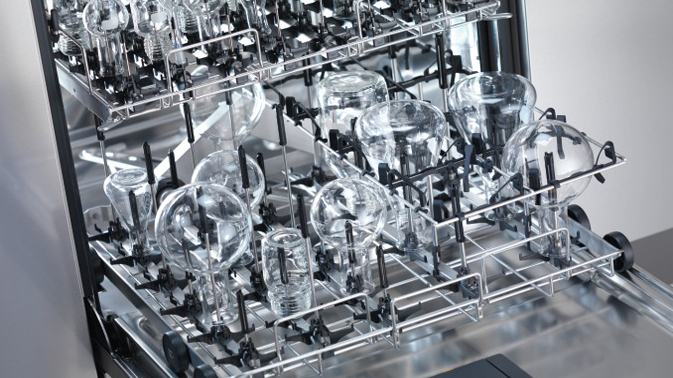Discover the basics of laboratory glassware reprocessing

Discover the basics of laboratory glassware reprocessing
Laboratory glasswashers – the scientific equivalent of your household dishwasher – are the unsung heroes of the world of science. But how much do you know about them? This article covers some of the most important things to understand to keep your laboratory supplied with sparkling glassware.
The basics
Lab washers are single-chamber, closed systems that use water and process chemicals to clean, rinse, disinfect – if necessary – and dry laboratory glassware. They can be free standing or integrated into the laboratory furniture, and come in all sizes – from small washers with a hinged door to large chamber systems with one or two, often vertical, doors – to suit varying reprocessing needs. Two-door lab washers are chiefly found in reprocessing rooms divided into a ‘dirty’ side, where the contaminated glassware is loaded into the machine, and a ‘clean’ side, where reprocessed glassware is removed ready for use. Reprocessing is performed via the fresh water circulation principle; fresh water is used for each programme block and then completely drained off. Successful reprocessing depends on both the quality of the water and the correct use of corresponding process chemicals.
Features and load carriers
The central elements of a lab washer are the cleaning system and components such as the circulation pump, spray arms, water softener, dosing system and dryer unit; a conductivity meter, spray arm speed sensor and water pressure monitor may also be included. Additionally, some lab washers incorporate a dryer, where ambient air is drawn in through prefilters and a high-efficiency particulate air (HEPA) filter, warmed and circulated into the wash chamber to dry the reprocessed glassware.
Depending on the model, hot, cold, demineralised and ultrapure water connections will be available. Softened hot or cold water is used for cleaning, while demineralised or ultrapure water is used for the rinse cycle. Smaller lab washers have an integrated softener with an internal reservoir for the salt, while larger systems require a separate softening unit. A filter system removes both coarse and fine particles from the rinsing liquid, preventing them from entering the chamber.
Powder or liquid process chemicals can be used for cleaning; powder detergent is added to a dosing compartment integrated into the door of the washer, and liquid process chemicals are introduced using dosing pumps. These may be peristaltic pumps – ideal for dosing of smaller volumes – or the bellows and membrane pumps typically found in larger lab washers. With liquid process chemicals, the required volume can be dosed automatically depending on the selected programme. A dosage monitoring system ensures that the flow and volume of detergent are correct, with the advantage that the potential for under- or overdosing inherent in manual procedures is eliminated.
Programme cycles are initiated and monitored during reprocessing via an in-built control panel, with data documented electronically via software or printed. Depending on the model, the most important parameters – such as temperature or cycle times – can be exported for archiving, enabling full traceability and establishing the reproducibility of the processes.
Finally, correct reprocessing of lab glassware requires the correct load carriers. Some carriers can be used with only one type of laboratory glassware, others accommodate mixed loads, such as a combination of wide neck jars and lids. Some load carriers even feature additional spray arms for enhanced reprocessing, while carriers with injector nozzles are used to ensure thorough cleaning of the interior of glassware with a narrow neck.
Selection criteria for specific applications
Before investing in a lab washer, take time to consider the laboratory’s specific requirements for glassware reprocessing, including:
The degree of cleanliness required. For some applications, even trace residues may interfere with subsequent analyses.
The quantity and type of labware to be reprocessed.
The most appropriate type of carrier; cleaning with a spray arm is suitable for wide neck glassware, such as beakers, while a load carrier with injector nozzles is required for adequate internal cleaning of narrow neck labware, including round-bottomed and volumetric flasks, and pipettes.
How much space is available.
Is a two-door system necessary to ensure that contaminated and clean glassware are kept separate?
Careful thinking prior to choosing and implementing a lab washer will ensure efficient, effective reprocessing for many years to come.